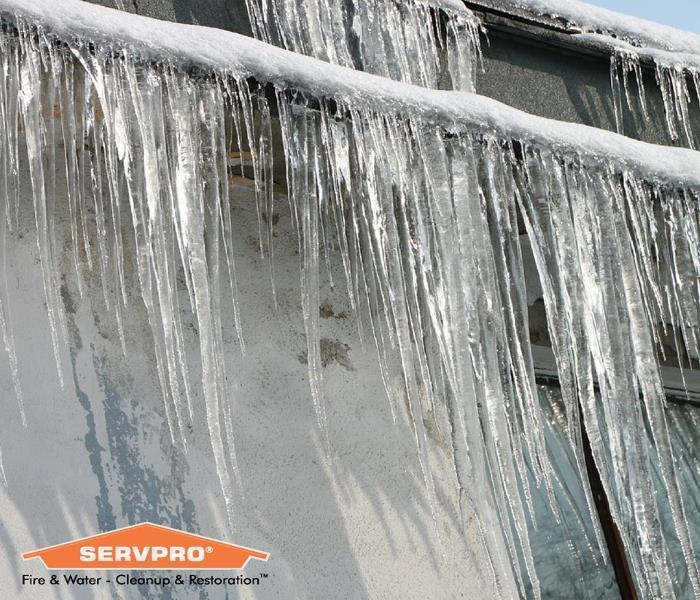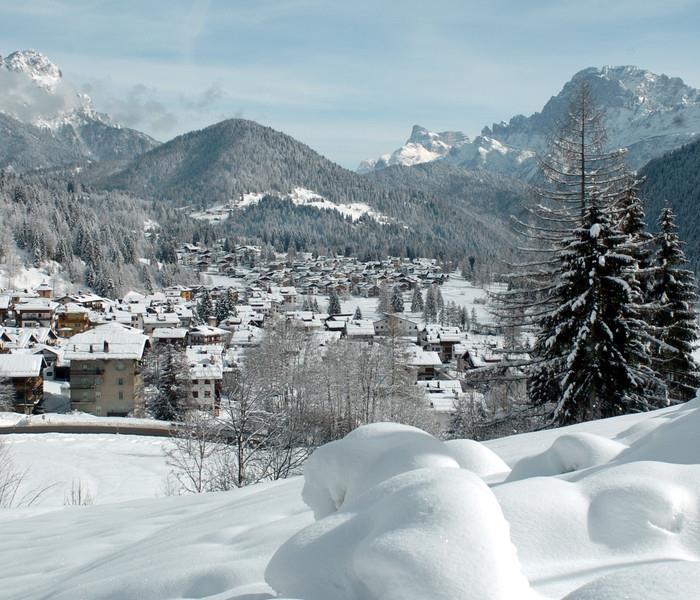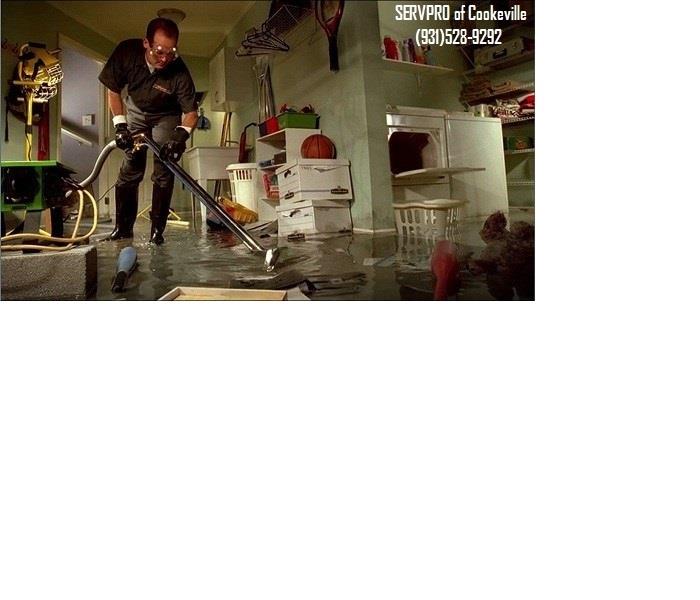Archived Water Damage Blog Posts
Easy Flood Prevention for Homes During the Fall Season | SERVPRO of Cookeville/Carthage/Smithville/Woodbury
10/15/2024 (Permalink)
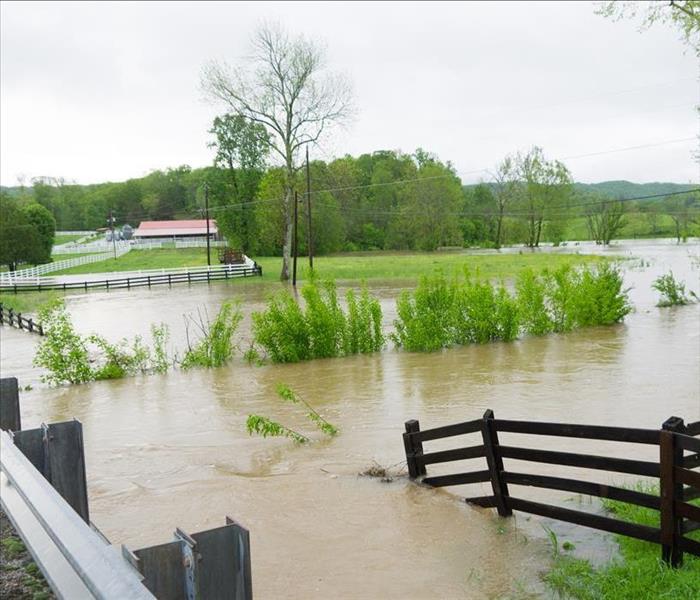 When flooding strikes, call SERVPRO of Cookeville/Carthage/Smithville/Woodbury for a faster response to recovery!
When flooding strikes, call SERVPRO of Cookeville/Carthage/Smithville/Woodbury for a faster response to recovery!
As the leaves begin to change and the air turns crisp, fall can bring a unique set of challenges for homeowners. One of the most significant concerns is the potential for flooding. But don’t worry! With a few simple steps, you can protect your home from water damage and enjoy the season without any stress. Here are some easy flood prevention tips to keep your home safe this fall.
Clean Your Gutters and Downspouts
Gutters and downspouts are your home’s first line of defense against water damage. When they’re clogged with leaves, twigs, and debris, water can’t flow properly and may overflow, leading to potential flooding around your home’s foundation.
Tips for Effective Gutter Cleaning:
-Regular Maintenance: Clean your gutters at least twice during the fall season.
-Use Gutter Guards: Install guards to keep large debris out while allowing water to flow through.
-Check for Damage: Look for any cracks or loose sections and repair them promptly.
Inspect and Seal Your Home’s Foundation
Water can seep into your home through cracks in the foundation. To prevent this, it’s crucial to inspect your foundation and seal any potential entry points.
To Check Your Foundation:
-Outside of Your Home: Look for any visible cracks or gaps. Clear away leaves, sticks and other debris that may have gathered from around the foundation and check for moisture. Add organic materials to create a gentle slope away from your home to keep water out.
-Inside of Your Home: Check corners, door frames and window frames to ensure everything is well sealed. Do this on a sunny day—too much light coming in from outside would indicate a crack or opening. Musty odors are another key indicator that water could be seeping in. Use your nose to find the source of the odor as a way to help you pinpoint spots that need to be resealed.
Maintain Your Yard and Landscaping
Your yard’s grading and landscaping can significantly impact how water flows around your home. Proper yard maintenance can help divert water away from your foundation.
Landscaping Tips:
- Ensure Proper Grading: Make sure the ground slopes away from your home’s foundation.
- Plant Strategically: Use plants and shrubs to help absorb excess water.
- Install a French Drain: Consider adding a French drain to help redirect water away from your home.
Check Your Sump Pump
If your home has a basement, a sump pump is essential for preventing flooding. Ensure your sump pump is in good working order before the heavy fall rains begin.
Sump Pump Maintenance:
-Test the Pump: Pour a bucket of water into the sump pit to ensure it activates and drains correctly.
-Clean the Pit: Remove any debris that could clog the pump.
-Backup Power: Consider a battery backup system to keep your pump running during power outages.
A Well-Maintained Home is a Dry Home
By taking these simple steps, you can significantly reduce the risk of flooding in your home during the fall season. Regular maintenance and a proactive approach will keep your home dry and safe, allowing you to enjoy all the beauty and fun that fall has to offer without worry.
Even the most prepared home could still see damage due to flooding. If you do, don’t hesitate to contact SERVPRO of Cookeville/Carthage/Smithville/Woodbury for a fast recovery.
Keep Your Home Safe From Flooding | SERVPRO of Cookeville/Carthage/Smithville/Woodbury
2/22/2024 (Permalink)
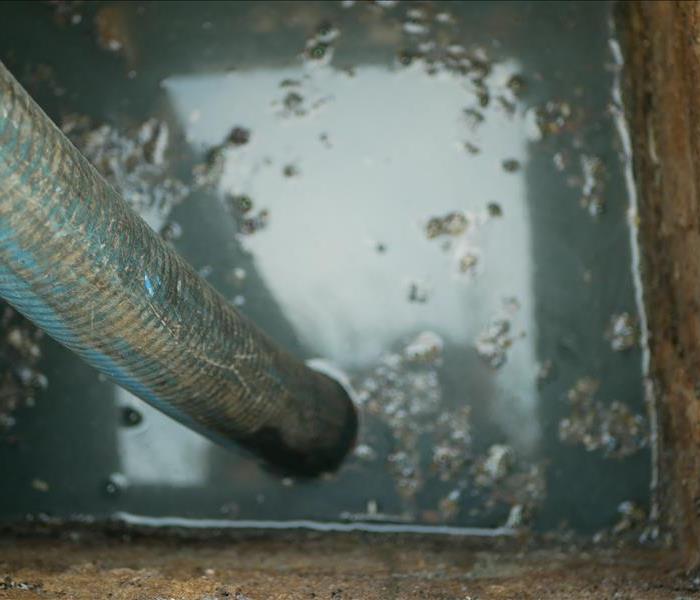 Is your home experiencing the aftermath of a flood? Call SERVPRO of Cookeville/Carthage/Smithville/Woodbury now, we are here to help.
Is your home experiencing the aftermath of a flood? Call SERVPRO of Cookeville/Carthage/Smithville/Woodbury now, we are here to help.
When you think about flooding, do you picture towns along the banks of a large body of water, or coastal areas with sandy beaches and the ocean in their backyard? While these locations are certainly very vulnerable to flooding, floods can happen anywhere, at any time.
Flooding costs enormous sums of money every year around the nation. As natural disasters continue to increase both in number and strength, it is important to prepare your home for every potential disaster that could arise.
There may be no stopping floodwaters when they stem from strong storms, but you can prepare for them. With preparation, you can prevent extensive damage and avoid the need for costly repairs.
Before, During and After
The best way to keep your home safe from flooding is to know what to do before, during and after a disaster strikes. When you have a plan, you can quickly take action when the weather is predicted to get wet and water is predicted to get high. With water damage especially, the faster you move, the less damage you will have.
Before a flood, get to know your home’s individual risks. Take a look at FEMA’s flood map, and take note of your zone. Check with your insurance agents to make sure you are appropriately covered as well.
If floods are predicted, put important paperwork in a watertight container and store it on a high shelf. If you can, shut off the electricity in your basement and clear out your belongings. Make sure your sump pump is working well if you have one, and if you don’t, consider adding one to keep water moving out.
During and after a flood strikes, make safety your priority. If floodwaters are entering your home, do everything you can to stay out of them. Find a safe location on high ground to ride things out.
As soon as you can safely do so, call us to start getting water out quickly. Take photos of your damage to help with your insurance claim and keep track of things.
Regular Prevention
While knowing what to do when flooding is imminent is a great way to keep yourself safe, there is also some regular prevention you can do around your home in order to stay prepared even when things happen suddenly.
Keep your gutters clean to make sure rainwater runs away from your home easily. Repair roof issues quickly, and inspect your roof thoroughly twice a year and after any major wind event.
Take a look at the seals around your windows and doors periodically as well. Replace caulking that has deteriorated in order to ensure water stays out even when rain gets heavy.
You should also walk your basement if you have one and around the exterior of your home at least twice a year. Fill in cracks, and make sure things are still watertight. If your gutters are loose or disconnected anywhere, be sure to fix them right away. The more you can do to keep water out, the less damage you will have.
Get to know your risks, make a plan for emergencies and keep your home prepared.
Has flooding affected your home? Contact us for fast restoration.
What Can Cause Secondary Damage After a Flood?
7/29/2022 (Permalink)
A flood, fire or any disaster that involves the quick spread of large amounts of water can quickly lead to further damage from black mold formation at your home in the Upper Cumberland.
What Is Secondary Damage?
This type of damage begins to take hold soon after the threat of the original disaster is under control. It is often due to:
- Improper sanitization measures
- Delay in drying efforts
- Insufficient repairs
- Poor ventilation
Mold is among the most prevalent causes of damage in the aftermath of a flood. It can quickly form and spread in various circumstances, such as after using a fire hose to extinguish flames, when plumbing pipes freeze and break or when water enters a home through cracks or a faulty foundation during a severe storm.
What Is the Best Way To Prevent Black Mold After a Flood?
The most reliable way to avoid mold following a flood is to dry out your space immediately. When dealing with large volumes of water, it is best to contact a professional disaster restoration service to apply urgent and rigorous mold prevention measures. Flood recovery teams can use industrial-strength water extraction machines to reduce high humidity quickly and efficiently remove excess water before it leads to mold.
What Are Some Ways To Manage Mold After It Starts To Form?
If mold has already taken hold, professional restoration services can undertake mold remediation to prevent it from spreading. For example, air filtration and ozone treatments can remove hazardous mold spores and their musty odors from the air. When water saturates walls or ceilings, removing and replacing mold-infested drywall can prevent more severe structural problems. Immediate action can mitigate damage after a flood and may raise the chances for a successful insurance claim to defray post-flood expenses.
Secondary damage from black mold formation is avoidable if you take immediate steps to control high humidity and dry your space after a flood. When in doubt, contact a professional flood restoration service for sound advice.
A Few Answers Related to Home Water Damage
7/29/2022 (Permalink)
When water overruns the interior of your home, you are likely to have many questions. Your first impulse might be to try and fix things on your own, but any significant flood event requires professional help. You might wonder, "Who should I call?" For major plumbing problems, a plumbing contractor can come to your home and repair the problem. For help with the cleanup and restoration, a local water mitigation company in Cookeville, TN, will have the resources and the personnel to minimize property damage. Technicians will arrive at your home in a matter of hours. They will use advanced equipment and hard-earned knowledge to restore your home to its proper condition.
The Question of Insurance Coverage
Water damage in your home inevitably becomes a financial issue. You will need to repair and replace items and there will be expenses for restoration services. To get the best information, it is vital that you call your insurance agent. In general, though, so long as the water mishap was unexpected and sudden, your homeowner's policy will cover some or all of the following expenses:
- Damage to the structure of your home
- Damage to personal items
- Costs to fix broken pipe
- Costs for restoration services
A flood that originates from the outside of your home is typically not covered. For this you need specific coverage for the overflowing of water into your house.
The Question of a Complete Restoration
How do you determine when your home has been completely restored after water damage? You should make sure all standing water has been removed from impacted areas. It is important to ensure the area has been dried out properly. This can be difficult to determine, so be sure to ask the company doing your cleanup. A reputable franchise will give you an honest answer. Also, pay attention to any lingering odors and insist those are addressed.
A flood in your home is a troubling event. You can overcome this temporary problem with quality help from professionals.
3 Easy Home Maintenance Tips to Help You Prevent a Water Damage Event
6/30/2022 (Permalink)
Water damage can be a costly and devastating event. At SERVPRO of Cookeville, we have often found that careful maintenance can diminish the risk and costs of water damage restoration. The water damage restoration process can be stressful, but by following some simple home maintenance tips, you can help prevent flooding from structural or maintenance issues in your home.
1) Assess your water heater to minimize water repair risk.
Water heater issues are common when it comes to our emergency water cleanup calls in the Upper Cumberland. With regular maintenance, you can prevent a surprise water heater flood in your home. Make sure the water heater's thermostat is regulating the temperature properly to prevent pressure buildup that can cause a water leak.
If you notice an odd taste or odor in the water from your water heater, it may have rust or sediment buildup inside. Also, if your water starts to make strange noises, it could need inspection or replacement to prevent a surprise flood.
2) Inspect your appliance hoses and connectors for leaks and replace them if they start showing wear.
Look for any cracks, kinks, unraveling, wear, or corrosion on the hoses and connectors. If you find any damage, replace them immediately. Most manufacturers and plumbers also recommend replacing water hoses and connectors every 3-5 years to prevent surprise water damage issues.
3) Replace old caulking in your windows and doors to prevent wet areas and moisture around the windows.
We often get calls for mitigation work in the Upper Cumberland for this kind of mitigation work. Caulking your windows can not only stop water leaks but also help to keep out drafts. It is a simple process that you can do yourself. Most window caulks should last about five years, but you should inspect your caulking every year and replace it if you notice any cracks developing or if you see it pulling away from the window.
You should also check your exterior door flashings for holes or rust that can allow water entry. If your doors are properly caulked, you can also help prevent premature flashing failure.
We are Here to Help for All of Your Water Repair Needs
If you or someone you know needs water damage restoration service, our team at SERVPRO of Cookeville is Here to Help!
Save our number for the future or call today for rapid response from our IICRC trained water restoration technicians.
Call today! 931-528-9292.
3 Steps to Take After a Pipe Break
6/30/2022 (Permalink)
After a Pipe Break, Follow These 3 Steps
Many homeowners in the Upper Cumberland worry about a flash flood when the weather outside gets a little too wet. However, one commonly overlooked source of flooding is bursting pipes. A homeowner should contact a professional to fix a broken pipe immediately. It is the only way to curtail the level of water damage from getting any worse.
1. Stop the Flow of Water
The first thing you as a homeowner can do is prevent the flooding from getting any worse. You will need to shut off the main water line. After you do so, you still need to drain the pipes of all water. This will require you to run every sink and flush each toilet in your house at least once. You will also need to turn off your home’s water heater. Once there is no running tap water left, the leak should stop entirely.
2. Inspect the Damage
Next, you will need to locate the burst pipes. If you are able to find the broken pipe, then you should take pictures of the damage for insurance purposes. If you cannot find the culprit, then you will need to bring in a professional crew as soon as possible.
3. Contact a Professional Drying and Remediation Crew
For homeowners in Cookeville and surrounding areas who think they are fairly handy around the house, it is always a good idea to call a professional team to take care of any water damage just to be safe. There is a lot of remediation that needs to take place, such as drying any damaged structures and preventing mold growth. Professionals also know how to safely work around water to prevent electrocution or illness.
It only takes a matter of minutes for bursting pipes to wreak havoc on your home. The faster you can respond to such an emergency, the better off you and your family are sure to be.
Water Damage Repair in Cookeville
9/1/2021 (Permalink)
If you have lived in the Upper Cumberland for long enough, chances are, you’re aware that we get quite a lot of rain, which can lead to frequent flooding. Losing all of your precious belongings (and with that, memories) in a relentless torrent can undoubtedly be mentally, emotionally, and physically overwhelming. Thankfully, we have the expertise required to help you restore what was lost and get back to a new normal after water damage to your home or business.
Safety First, Safety Second…
- As always, in these instances, your number one priority should be safety. Is it safe to stay inside your home or business?
- You should be sure only to do indoor activities that are safe for you to perform post-flooding.
- Don’t push yourself to lift too many objects, because wet materials can be VERY heavy- be careful!
- Some of the most prevalent concerns involving water damage are electrical hazards and “slip and fall” incidents, so be aware of the damage post-flood.
How Do I Restore My Belongings After Water Damage To My Upper Cumberland Home Or Business?
- Here at SERVPRO of Cookeville, our philosophy of “restore” and not “replace” motivates us to help you restore your items as if they were our own, and we work tirelessly to make sure your belongings are as good as they were pre-flood. As a result, we first pretest your contents to start this process.
- Next, we utilize several methods to clean your materials, including dry cleaning, wet cleaning, spray and wipe, immersion cleaning, foam cleaning, and abrasive cleaning.
- Suppose your home or business requires intensive cleanup and restoration. In that case, SERVPRO of Cookeville can coordinate an efficient, effective, and stress-free move-out of the affected area(s). This provides several benefits, including a quicker remodeling process and protecting items from further damage.
- We also provide electronic cleanup, photograph, and document drying services, and contents claim inventory services.
If you find yourself needing extra guidance on a trying and emotional experience such as water damage repair in the Upper Cumberland, look no further than SERVPRO of Cookeville! As trusted leaders in the restoration industry, we pride ourselves on our ongoing training and rapid 24/7 emergency response because we know that natural disasters don’t come announced! Contact us today at 931-528-9292.
This franchise is independently owned and operated.
How SERVPRO of Cookeville Restores after a Flood
8/31/2021 (Permalink)
When a flood happens inside your home, there are many different areas of the home that can be affected. Water damage from floods can destroy your home’s structure, carpet, flooring, and more. Electrical problems often occur after home flooding and there are many steps that need to be taken to start repairing the damage the flood has caused. See the steps that SERVPRO takes to restore properties following flood damage in the Upper Cumberland.
Step 1 - Emergency Contact
We understand that water damage can come at any time so we’re ready to field your emergency call 24/7 to ensure a timely response. Once receiving your call, our specialists are trained to ask you several simple questions that will help us understand what needs to be done to your property.
Step 2 - Inspection and Water Damage Assessment
Once we have all of the information we need, our team will arrive promptly at your property to assess the water damage personally to determine the best course of action. During this assessment, our team will check the moisture levels of your property, survey any damages that may have occurred, and identify the types of water present in the area.
Step 3 - Water Removal / Water Extraction
Depending on the amount of water that makes up your flooded space, our team may use powerful submersible pumps in addition to industrial strength, wet/dry vacuums. We also use a variety of water extraction equipment such as moisture detectors, hygrometers, and other meters to measure the extent of moisture saturation in your space along with truck-mounted and portable extraction units that perform efficient water removal.
Step 4 - Drying and Dehumidification
After taking careful measurements to determine the optimal number of air movers and dehumidifiers to dry your home or business., the SERVPRO team will dry and dehumidify your space. While the space is drying, our team will check the moisture levels of all pertinent floors and walls to monitor the drying process so that swelling and warping of floors, walls, and furniture doesn’t happen.
Step 5 - Cleaning and Sanitizing
Our team understands that even if the water is out, you still aren’t out of the woods when it comes to water damage odor removal, and deodorization. Our technical expertise and industrial-grade air scrubbers and fogging equipment go well beyond simply masking odors. Depending on the scenario, we may use antimicrobial, antibacterial, or disinfectant treatments to clean your property. Furthermore, we will remove and dispose of damaged materials with guidance from you and your insurance adjuster.
Step 6 - Restoration
Restoration is the final step in the equation. Restoration may involve minor repairs, such as replacing drywall and installing new carpet or may entail major repairs, such as the reconstruction of various areas or rooms in a home or business. If you’re looking for someone to simplify the restoration process by handling both the initial water damage mitigation and rebuilding the affected areas, then look to the team at SERVPRO.
Choosing SERVPRO for your Water Damage Restoration Needs
The best part about sticking with SERVPRO is that you can rest assured that every team member has extensive water damage restoration training that helps you get back to normal more quickly. Their dedication to responding immediately to water emergencies lessens the damage, limits further damage, and reduces your costs. Make sure to call SERVPRO of Cookeville/Carthage/Smithville/Woodbury at 931-528-9292 if you’re in need of water damage restoration following a flood.
3 Tips for Preventing Water Damage
6/10/2021 (Permalink)
Prevent Water Damage In Your Home
Water is one of the most common causes of damage to homes in the United States. Melting snow and ice, heavy rains, burst pipes and leaky plumbing make water in home a year-round threat for damage. These three tips can help you prevent water damage to your home.
1. Disconnect Hoses in the Fall
Outdoor hoses that are left connected to water sources during the winter can freeze and cause ice blocks that may restrict water flow or cause a broken pipe. To avoid this problem, hoses should be drained and disconnected before winter weather arrives.
2. Learn Where Your Water Main Shutoff Is and How To Operate It
Your water main is responsible for supplying water to your entire house. One of the first things you should do when a water emergency, such as a broken pipe or an overflowing toilet, causes water in home is to close your water main shutoff. This action prevents water from being distributed to the rest of the pipes in your house and stops additional water from leaking into your home. Once you have stopped the flow of water, you can call a water remediation company in the Upper Cumberland, to dry out your home. It can also be a good idea to shut off your water when you will be away from home for an extended period of time.
3. Maintain Trees and Other Plants in Your Yard
The roots from trees and shrubs that are too close to your home can grow into or wrap around pipes and cause leaks or broken pipes. Removing these plants from areas near your plumbing is an important part of your pipe cleanup plan.
Water in the home can cause a significant amount of damage. There are steps you can take to mitigate water damage, but it is best to avoid it altogether by following these tips to prevent water damage.
3 Ways To Prevent Clogged Toilets
6/10/2021 (Permalink)
Take The Following Steps To Help Protect Your Building
Keeping your bathrooms clean and functioning properly can be a hassle in commercial buildings. After all, you never know exactly who is attempting to flush what down your precious septic system. While you may not be able to control many clogged toilet scenarios, there are a few steps you can take to help protect your building in the Upper Cumberland.
1. Post Signs and Notices
A few simple instructions can go a long way for most visitors. If you prefer that customers dispose of feminine hygiene products in specifically marked wastebaskets, as opposed to flushing them down the toilet, then hang up a sign asking them to do so. Many people do abide by the laws of common courtesy and a simple reminder can help prevent unwanted toilet overflow.
2. Opt for Thinner Toilet Paper
Thicker, more luxurious toilet paper is preferable for home bathrooms, but it might not be the best choice for your commercial ones. Customers who tend to use thicker wads of toilet paper pose a risk to your sewage system. Thinner paper is much less likely to clog up the pipes.
3. Provide Plenty of Trash Cans and Waste Baskets
If there aren't any trash cans available, customers often choose to flush trash down the toilet. They may believe that it's a much more polite alternative than leaving trash on the counters or floors, but your clogged toilet tends to disagree. Offering plenty of places for customers to discard their trash is a simple and effective way to prevent these accidents from happening.
A clogged toilet is an unpleasant sight in any commercial bathroom. Protecting your bathrooms isn't just about preventing septic issues, it's also important to leave a good impression on your customers. The pointers above can certainly help maintain harmony in your commercial bathroom, but there's no real way to prevent disaster entirely. If you do discover septic issues in your building, it's important that you call flood remediation experts as soon as possible.
Ceiling water damages deserve undivided attention.
6/7/2021 (Permalink)
There is nothing more horrifying than sitting in your living room one day, and you notice an unsightly brown projection beginning to peel from your ceiling. You may be wondering why there is a brown spot and how it may have gotten there. After a few Google searches, you realize that your ceiling has been damaged by water. Instead of worrying, start thinking about what action steps to take next.
Although any water damage situation can be stressful, there is good news; if you are reading this post, you likely recognized the sign of ceiling water damage early on. Finding ceiling water damage at early stages allows a homeowner to avert further structural damages.
In this blog post, we will be going over five actionable steps you, as a property owner, should take after finding out that you have a ceiling water damage issue.
Step 1: Address your water damage ceiling situation calmly.
When it comes to water damage repair, we tend to be distressed over the situation and rashly make decisions. Oversee the damage calmly and make an informed decision whether to address it yourself or to seek professional help. It is essential to be aware that quickly addressing a water damage situation can save a property owner from more significant expenses.
Step 2: Find the source of the water damaged ceiling.
There are two primary sources of why a water damaged ceiling may be occurring. The first possible cause of the water damaged ceiling may be the result of a roof leak. A clear sign that you have a roof leak will be clearly shown when your ceiling only gets wet after rainfall.
Another likely cause of a water damaged ceiling is when a property has a pipe brake or defective plumbing pipes. Malfunctioning plumbing piping will lead to water damage when a pipe begins to drip in between the drywall.
Step 3: Remove all water damaged materials.
When you have a water damaged ceiling, remove all the wet materials so that mold will have a less likely chance to grow. There is more to a water damaged ceiling than wet drywall. Inside your wet drywall will also be wet insulation; both materials need to be removed.
Step 4: Check for signs of mold damage.
Whenever there is impending water damage, one of the likely outcomes to watch out for is mold growth. Mold is a type of fungi that can live and thrive anywhere with a little bit of moisture. The professionals at SERVPRO know they have a 48-hour window to mitigate water damage before mold begins to grow. When you find mold, it is essential to contact a professional in mold remediation to ensure a healthy environment in your home.
Step 5: Dry the water damaged ceiling
Once you have isolated and located the source, it is time to dry the damaged area. Water damage professionals use fans and dehumidifiers to dry water-damaged regions thoroughly. You can rent drying equipment at a hardware store, but it is best to hire professionals specializing in water damage repair services. Water restorers have all the necessary drying equipment and disinfectants to ensure your property is ready to be put back "Like it never even happened."
When to call the professionals at SERVPRO
As you learned throughout this blog post, ceiling water damage goes beyond aesthetics: mold can develop and cause severe structural damage. It is best to call the professionals at SERVPRO of Cookeville/Carthage/Smithville/Woodbury at the first sign of ceiling water damage. The professionals will ensure your water damaged ceiling is mitigated correctly and not prone to future mold growth.
The professionals at SERVPRO have witnessed many situations where a property owner has tried to mitigate the water damages on their own, causing more severe issues in the future.
Water damage mitigation is more than just placing drying equipment. The professionals at SERVPRO go through extensive water damage training to ensure all moisture is at proper levels and the property is free from future mold growth.
Contact us today to schedule an inspection when you think or know your property has a water damage issue. We are available 24/7 every day of the year for disaster mitigation!
How Can A Clogged Dishwasher Drain Hose Cause Water Damage?
6/7/2021 (Permalink)
The water damage professionals at SERVPRO have restored many water damages from a clogged dishwasher drain hose.
Dishwashers are an easy and comfortable part of our lives in our modern society. We load the dishwasher with the day's dishes, run a cleaning loop, and then spend the next hour doing other things. It is easy for us to take getting a functioning dishwasher for granted before it suddenly stops working.
A common reason for a dishwasher to malfunction is when food, paper, and other debris collect in your dishwasher drain hose and cause a clog. A clogged dishwasher drain hose will trigger backups and limit a dishwasher's efficiency.
If your dishwasher develops a clog of some kind, you might be in for some severe problems, mainly when it overflows. Dishwasher water damage does not end here; if it goes unnoticed for long, it can cost you serious secondary damages.
In this blog post, we will go over the early signs to look for when you think your dishwasher drain hose is clogged, actionable steps to unclog the drain hose, and who to call for water damage restoration.
What does a clogged dishwasher drain hose look like?
Underneath your dishwasher unit, there is a drain hose that can crack, clog, and deteriorate over time, causing a water damage leak. Early warning signs of dishwasher leakage are frequently found under and behind the unit, where plumbing connections are hidden.
To ensure a well-functioning dishwasher, you should remove the front kickplate two to three times a year and search beneath the dishwasher for dripping or other signs of water leakage. It is best to check the unit for a clogged hose, both when it is turned off and filling.
When a clogged dishwasher drain hose goes unnoticed and untreated, it can easily become the cause of severe water damage to your kitchen and home in little time.
3 Early signs of a clogged dishwasher drain hose
1) Loud noises
Dishwashers are not known for being very silent, but the sound they produce is usually pretty predictable. If you hear uncommon noises coming from your dishwasher, it may be due to a clog.
2) Gurgling
It's never a positive thing if the drains are gurgling. Although this does not always indicate that you are dealing with a major plumbing problem, it does indicate that something isn't quite right. If you hear gurgling, it means there's a clog, or at least a partial clog, somewhere in either your drain hose or pipe.
3) Water overflow
When the dishwasher backs up into the kitchen sink, you know something is wrong. A dishwasher overflow indicates that the water is unable to flow due to a clogged drain hose.
How to unclog a dishwasher drain hose
If you've figured out what's causing your dishwasher hose to clog, make sure you're prepared to unclog your drains. Below we are going to be going over a way to unclog your dishwasher drain hose, but remember that it is always wise to hire a local plumbing professional with the right knowledge.
Tools you may need:
- Drain auger or snake.
- Gloves.
- Bucket
- Vinegar
- Phillips head/flathead screwdriver
- Baking soda
(Before starting any dishwasher repairs, unplug the unit!)
To start the unclogging process, you will want to remove the dish racks and then remove the drain grate with a screwdriver. Manually remove any visible debris and then use a mixture of baking soda and vinegar and let it sit for 15-20 minutes. After you let the solution sit, you can add boiling water down the drain hose. Reattach and reinsert the rack and grate and check to see if the dishwasher is properly draining.
Contact SERVPRO for dishwasher water damage restoration
At SERVPRO, we believe that no water damage is the best kind of water damage. You can count on the IICRC certified professionals at SERVPRO of Cookeville / Carthage / Smithville / Woodbury when your dishwasher malfunctions and causes water damage throughout your home. Your kitchen will be back in a pre-water damage state in no time with the help of our experts.
Contact us today! We offer 24/7 emergency services to all property owners throughout the greater Upper Cumberland area.
Flooding and Unforeseen Secondary Damage
8/31/2020 (Permalink)
Flood and water damage cleanup in the Upper Cumberland is both time-consuming and labor-intensive, but not completing the job properly can lead to problems later on. Secondary damage like black mold and drywall issues will eventually rear their head, and can be even more dangerous than the initial flooding.
Primary vs. Secondary
When you’ve experienced a flood or burst pipe, it may be easy to spot the initial damage to your property. Things get wet and need to be dried out, while water needs to be removed as quickly as possible. Secondary damage occurs over time and can have a variety of causes, including the following:
- Improper initial cleanup
- Unseen damage
- High humidity preventing evaporation
- Poor airflow through the site
- Hidden standing water
- Weakened pipes that burst at a later date
This continuous and slowly-evaporating moisture can lead to mold and other problems that can be more difficult to repair.
Warped Views
Hardwood flooring is especially susceptible to poor drying times. Water seeps into small micro-fissures in the wood grain and can lead to cracking and even warped floorboards. These pieces will need to be replaced, which is a costly venture when trying to match board color and width.
Other furniture can suffer from poor drying as well, including countertops forced out of shape thanks to rotting or warping supports. Without proper ventilation to allow moisture to evaporate effectively, there are many components that will need to be replaced.
Moldy Moulding
The greatest danger exacerbated by lingering moisture is black mold. This toxic substance will grow in the darkest spots of your home before you even realize it’s there. Often times drywall is the culprit, since it absorbs wetness easily but can hide it within walls, well out of sight.
In the Upper Cumberland, humidity is going to be a problem whenever you attempt to keep things dry. Invest in a dehumidifier to lessen its intensity. Whenever you have water damage from flooding or burst pipes, take the time to adequately air out your home to make sure water evaporated effectively, stopping the spread of black mold in its tracks!
4 Steps for Preventing Unexpected Water Damage While on Vacation
7/30/2020 (Permalink)
Follow These Four Steps Before Leaving for Vacation
The last you want to come home to after a long, relaxing vacation is a flooded house. However, water damage can easily occur to your home in the Upper Cumberland if a necessary water pipe repair or leaking faucet is left unattended for a long period of time. Left to sit long enough, flood waters can cause extreme damage to the structure of your house and will need to be addressed by a water damage restoration company. To prevent flooding from occurring to your home and damaging your belongings while you’re away, follow these four steps before leaving for vacation.
1. Clean Gutters
Make sure to remove all dead leaves and debris from gutters before heading out on vacation. If it rains while you are gone, a clogged gutter can lead to a leaky roof which can ultimately cause extensive water damage to both the interior and exterior of your home.
2. Check Water Pipes
Make sure to examine your home’s water pipes to check for any existing issues. If you do notice a problem with your water heater, pipes, or connecting hoses, make sure to perform a water pipe repair before departing to avoid a broken pipe.
3. Shut Off Water
If possible, shut off the main water valve while you’re away as an extra precaution. If you still need some water to run the sprinkler system or water plants, then turn off any water supply valves that won’t be used while you’re gone.
4. Get Help From a Friend
Ask a trusted friend or family member to check on your home occasionally while you’re gone. In addition to asking someone to water the plants and take out the trash, ask them to keep a look out for possible leaks.
It might seem convenient to put off a water pipe repair until after you get back from vacation. However, your future self will be thankful that you were proactive in protecting your home from water damage by following these four steps.
Injectidry Hardwood Floor Drying System
5/19/2020 (Permalink)
The Inject dry Hardwood Floor Drying System is the latest and greatest hardwood dryer in the industry. It's used to dry high-risk areas of moisture under hardwood, marble, and tile that regular dehumidifiers just can't quite reach. By exchanging the air in a targeted area with negative pressure, the air movement becomes a vehicle for moisture. When caught in time, this can keep your expensive hardwood and engineered hardwood from warping.
SERVPRO of Cookeville/Carthage/Smithville/Woodbury specializes in: water remediation, flood mitigation, carpet cleaning, tile and grout cleaning, mold removal, fire damage, and smoke clean up, disaster restoration, storm response, and air duct cleaning. SERVPRO of Cookeville/Carthage/Smithville/Woodbury serves the Upper Cumberland area.
We are licensed by the IICRC. Call us for any of your cleaning or restoration needs at (931) 528-9292.
Spock's Guide to Drying Water Damage
5/19/2020 (Permalink)
"Fascinating is a word I use for the unexpected; in this case, I would think interesting would suffice."
Water damage is something we come into contact with on a daily basis. Some days it's a small water leak from a loose plumbing fixture. Other days it's a three story loss from a sprinkler head bursting in a commercial building.
No matter the size, the same principals apply to drying a structure. There's a scientific technique behind the process, and here it is, explained by Spock:
"Once you have eliminated the impossible, whatever remains, however improbable, must be the truth."
The first step in the drying process is an inspection, also known as a Loss Assessment Report. Upon arrival, the water technician must first assess any health concerns and safety hazards. Depending on where the water came from (sewage compared to a washing machine overflow) there could be pathogens that have the potential for serious adverse health effects. Structural damage or exposed wires would be a safety concern.
Determining the source of the water intrusion is also important in the drying process. Before the drying can begin, the water source must be stopped and the extent of intrusion evaluated.
Once the water source has been stopped, the technician can begin scoping the damage. Moisture meters are used to determine the saturation of materials and borescopes can be used to view inside cavities for a better understanding of the structure's condition.
"A dazzling display of logic."
Logically, the next step in the drying process is to remove any standing water. The primary purpose of water extraction is to stop any further water migration. This prevents other surfaces and rooms from being affected, so it should be done as quickly as possible.
The other reason for water extraction is to speed up the drying time. The only ways for water to be removed from a home or business is evaporation or extraction. The more water that is extracted, the less that will need to be evaporated.
"Change is the essential process of all existence."
To completely dry a structure, a technician must increase the rate of evaporation from the wet materials. Evaporation will increase when the temperature is raised, when drier air is used, and when air is moved across the wet surface.
In order to achieve this, a number of different types of equipment is used. Air movers are essentially compact, high velocity fans. By strategically placing them in an affected area, the air movers help accelerate the rate warm air heats the surfaces. Industrial dehumidifiers balance the drying system by removing the moisture that air movers sweep away from wet materials.
"Insufficient facts always invite danger."
A lawyer will tell you if it's not documented, it didn't happen. In the restoration industry all activities that relate to a job should be documented by the water technician. After the first 24 hours of drying, materials should be monitored to determine if progress has been made. The materials should be monitored every 24 hours after, until the drying has been completed.
If you've had water damage in your home, call SERVPRO of Cookeville/Carthage/Smithville/Woodbury for 24/7 emergency services.
Flood Water
4/30/2020 (Permalink)
Flooded areas are not only a hassle to clean, but can also threaten your health. Water that flows in from outside of your house can pick up a lot of bacteria on the way before it even enters the house. Having the water sit, especially on a humid day, can cause more bacteria and mold growth. Getting the area cleared out and cleaned up as fast as possible will prevent the situation from getting worse and causing more water and mold damage.
According to the IICRC, these are valuable tips for cleaning up after a flood has left water damage in your home.
- Safety is first and foremost. Be cautious when entering buildings that have been flooded. Ensure that the electric is turned off and the structure of the building is safe to walk into.
- Keep the area ventilated. Flooded waters can bring in all different types of bacteria that can become airborne and cause illness. Make sure to open windows and place a fan in the window to ventilate the area.
- Know what to throw away and what to salvage. Any type of porous item the absorbs the contaminated flood water should not be salvaged. Examples-drywall, carpet, mattresses, pillows, box springs, and particle board. Clothing and some other household fabrics may be salvageable by soaking in warm water and washing multiple times.
- Prevent mold growth. With the moist environment that is created by a flood, there is lots of room for mold to grow. Try to keep the air circulating and maintain moderate temperature to prevent mold growth.
As leaders in the water damage industry, SERVPRO of Cookeville/Carthage/Smithville/Woodbury has advanced training and expertise, not to mention a tremendous amount of hands-on experience. We use this training and experience to quickly dry your home and restore it back to pre-water-damage condition. Our process includes documentation of the drying process to validate your property is dry.
Source-http://www.IICRC.org/consumers/care/water-damage/
Customer Praise For Water Leak
3/31/2020 (Permalink)
There's been lots of work to do with the excess rain we've had in the Upper Cumberland lately! Here are a couple of customer reviews on the work we've completed for flooding and water damage.
Mr. Loftis had to say this about our work:
"Ice maker leak, undetected for days, maybe weeks, damaged my hardwood floors. SERVPRO came in and set up drying equipment the next morning, arranged for a flooring company to do the replacement and arranged everything else. Love these guys! Highly recommend them."
Mrs. Robbins had these kind words:
"SERVPRO of Cookeville did an awesome job after we had some water damage. We highly recommend their services. They were professional, courteous and caring at all times. Lesa, in the office, is wonderful to work with. Very dependable team."
Flooding and Unforeseen Secondary Damage
8/28/2019 (Permalink)
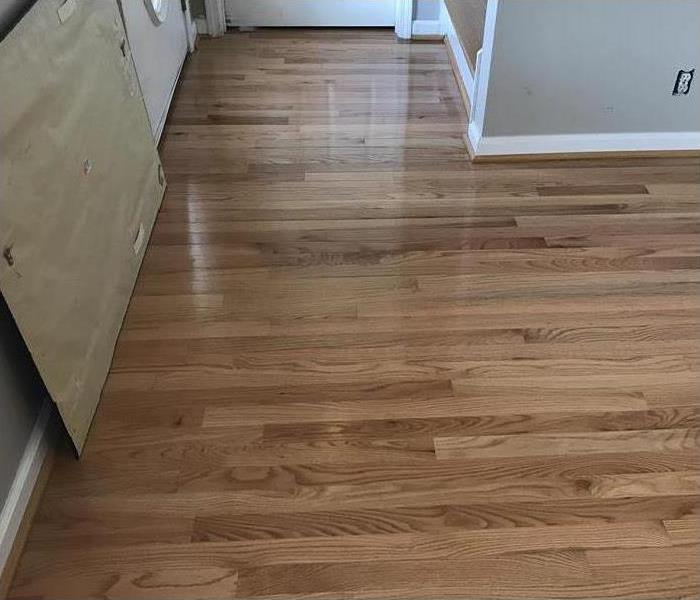 Hardwood water damage after pipe break in a Smithville,TN home
Hardwood water damage after pipe break in a Smithville,TN home
Flood and water damage cleanup in Smithville, TN, is both time-consuming and labor-intensive, but not completing the job properly can lead to problems later on. Secondary damage like black mold and drywall issues will eventually rear their head, and can be even more dangerous than the initial flooding.
Primary vs. Secondary
When you’ve experienced a flood or burst pipe, it may be easy to spot the initial damage to your property. Things get wet and need to be dried out, while water needs to be removed as quickly as possible. Secondary damage occurs over time and can have a variety of causes, including the following:
- Improper initial cleanup
- Unseen damage
- High humidity preventing evaporation
- Poor airflow through the site
- Hidden standing water
- Weakened pipes that burst at a later date
This continuous and slowly-evaporating moisture can lead to mold and other problems that can be more difficult to repair.
Warped Views
Hardwood flooring is especially susceptible to poor drying times. Water seeps into small micro-fissures in the wood grain and can lead to cracking and even warped floorboards. These pieces will need to be replaced, which is a costly venture when trying to match board color and width.
Other furniture can suffer from poor drying as well, including countertops forced out of shape thanks to rotting or warping supports. Without proper ventilation to allow moisture to evaporate effectively, there are many components that will need to be replaced.
Moldy Moulding
The greatest danger exacerbated by lingering moisture is black mold. This toxic substance will grow in the darkest spots of your home before you even realize it’s there. Often times drywall is the culprit, since it absorbs wetness easily but can hide it within walls, well out of sight.
In Smithville, TN, humidity is going to be a problem whenever you attempt to keep things dry. Invest in a dehumidifier to lessen its intensity. Whenever you have water damage from flooding or burst pipes, take the time to adequately air out your home to make sure water evaporated effectively, stopping the spread of black mold in its tracks!
4 Steps for Preventing Unexpected Water Damage While on Vacation
6/12/2019 (Permalink)
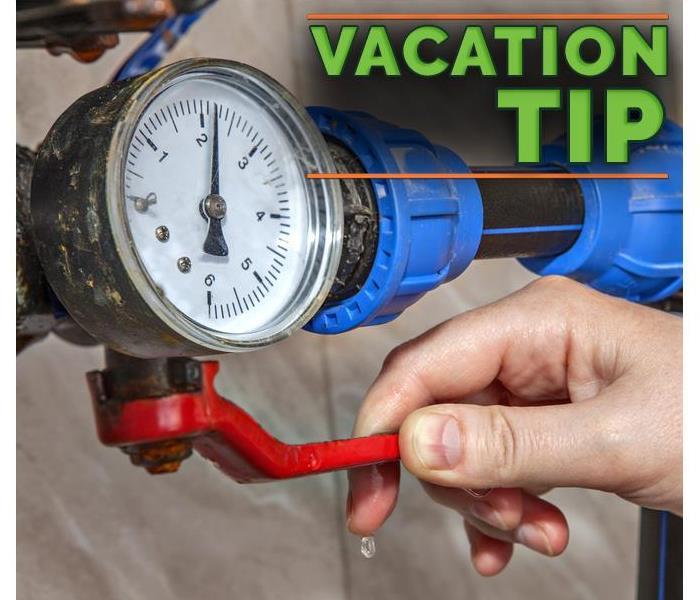 Remember to shut off the main water valve while you're away
Remember to shut off the main water valve while you're away
Follow These Four Steps Before Leaving for Vacation
The last you want to come home to after a long, relaxing vacation is a flooded house. However, water damage can easily occur to your home in Gordonsville, TN, if a necessary water pipe repair or leaking faucet is left unattended for a long period of time. Left to sit long enough, flood waters can cause extreme damage to the structure of your house and will need to be addressed by a water damage restoration company. To prevent flooding from occurring to your home and damaging your belongings while you’re away, follow these four steps before leaving for vacation.
1. Clean Gutters
Make sure to remove all dead leaves and debris from gutters before heading out on vacation. If it rains while you are gone, a clogged gutter can lead to a leaky roof which can ultimately cause extensive water damage to both the interior and exterior of your home.
2. Check Water Pipes
Make sure to examine your home’s water pipes to check for any existing issues. If you do notice a problem with your water heater, pipes, or connecting hoses, make sure to perform a water pipe repair before departing to avoid a broken pipe.
3. Shut Off Water
If possible, shut off the main water valve while you’re away as an extra precaution. If you still need some water to run the sprinkler system or water plants, then turn off any water supply valves that won’t be used while you’re gone.
4. Get Help From a Friend
Ask a trusted friend or family member to check on your home occasionally while you’re gone. In addition to asking someone to water the plants and take out the trash, ask them to keep a look out for possible leaks.
It might seem convenient to put a off water pipe repair until after you get back from vacation. However, your future self will be thankful that you were proactive in protecting your home from water damage by following these five steps.
Understanding the Typical Causes of Commercial Water Damage
4/15/2019 (Permalink)
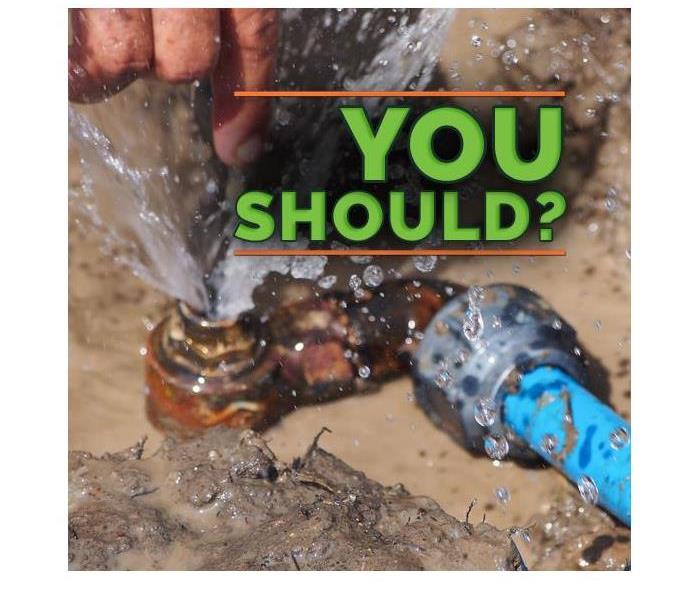 When you have a pipe burst, you should call SERVPRO
When you have a pipe burst, you should call SERVPRO
Whether you’re dealing with the everyday broken pipe or a substantial flooding problem that can lead to hefty water repair costs, it’s important that you understand the typical causes of most commercial water damage issues when you’re a business owner in Silver Point, TN. Here, we’ll dive into many of the usual culprits, helping you to achieve a better understanding of what can go wrong and how to be on the lookout for common signs before disaster strikes.
Faulty Pipes and Bad Plumbing Systems
Major commercial buildings have a lot of water passing through their pipelines on a daily basis. Therefore, it’s easy for excessive use to cause damages that can lead to worse problems like a broken pipe or leaky faucets. Since this is a fairly common issue, most experienced water restoration specialists can quickly address the situation before it becomes a bigger headache.
Failing Appliances
Depending on your line of work, you could have many appliances in your building that can result in future flooding, including:
- Dishwashers
- Water heaters, or
- Clothes Washers
To ensure that these appliances are working properly and they won’t lead to costly water repair, it’s best to conduct regular inspections so as to avoid any mishaps.
Toilet Overflow or Backed Up Sewer Lines
There’s plenty of opportunity for things to go awry when you’re dealing with commercial plumbing, and this includes overflowing toilets or potential sewer line blockages. Given the unpleasant and possibly hazardous nature of the issue, it’s important to let professionals handle the cleanup and restoration process in the right way.
See the Signs Ahead of Time
Being a business owner in Silver Point, TN requires wearing many hats, but when it comes to dealing with issues like a broken pipe or faulty appliances, there’s no time to let seemingly small problems linger. Understanding what can cause substantial water damage ahead of time leaves you more prepared for managing any situations as they arise, so knowing these typical causes is a surefire way to better handle any future predicaments.
3 Tips for Handling Noisy Water Pipes
3/19/2019 (Permalink)
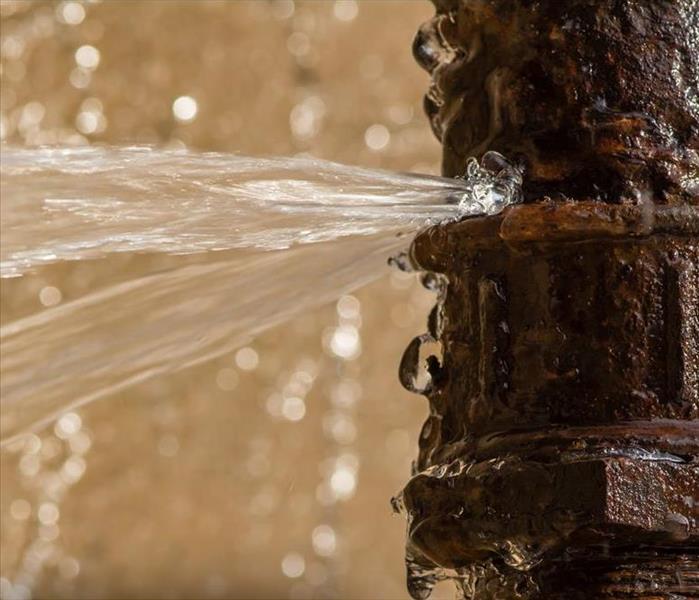 Contact SERVPRO for professional guidance.
Contact SERVPRO for professional guidance.
Precautionary Steps When A Pipe Break Is Ready To Happen
If you’re a homeowner in Carthage, TN, you’ve probably had to deal with noisy water pipes at some point in your life. The most common cause is too much water pressure coming through them, which causes that unpleasant hammering sound. Understandably, most people think these sounds are harmless, but it’s worth it to pay closer attention — they could be a warning sign of a pipe break ready to happen.
1. Know the Reasons Behind the Sounds
Your home’s pipes bring water from behind your wall to your fixtures and appliances. If those pipes get clogged, corroded, or frozen, there can be substantial damage. There could also be problems with your pipe installation; pipe straps and fittings play a crucial role in maintaining a steady water pressure. When that hardware malfunctions, it could result in a major pipe burst.
2. Proceed With Caution
If you can isolate where the sound is coming from, that’s a major step in avoiding a nasty pipe break. To isolate the sound, go to different parts of your home where the pipes connect and take note if any of them chatter, vibrate, or feel loose. Once you’re sure, shut off the water supply to that pipe or refrain from using it to avoid a burst and subsequent flooding.
3. Contact Specialists
Once you’ve taken some precautionary steps, consider reaching out to the water restoration specialists in Carthage, TN. They can accurately determine the problems with affected pipes and help you figure out what the next steps are. This can save you time and money in the long run.
Unfortunately, a pipe break often leads to substantial flooding and building material damage.
In this case, it’s important to fix the broken pipe (or pipes) rather than treating the symptoms of it. Fortunately, with some professional guidance, you’ll be on your way to getting your home back to normal.
What To Expect From Your Insurance Company After a Broken Pipe
1/17/2019 (Permalink)
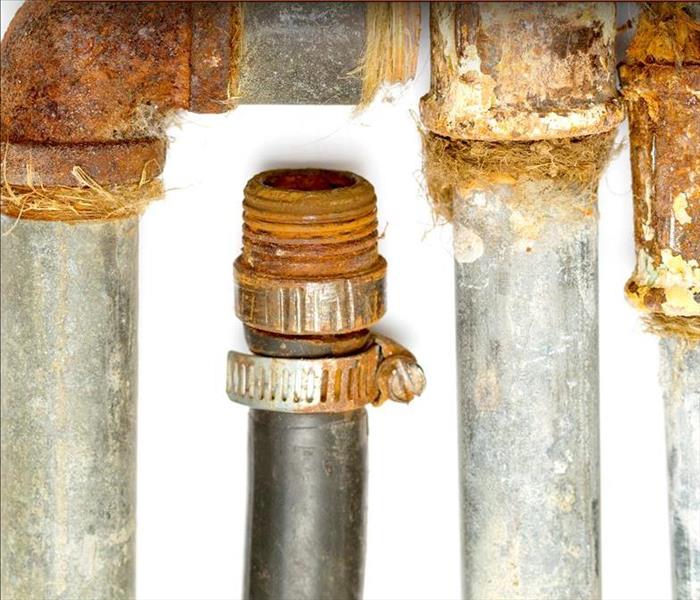 Not many insurance policies will cover the cost to fix a broken pipe in Carthage, TN
Not many insurance policies will cover the cost to fix a broken pipe in Carthage, TN
You walk into your kitchen and step into an inch of standing water. Upon quick inspection, you discover that a broken pipe under the sink is the cause of the flood. Your mind automatically starts figuring how much this is going to cost. Will your insurance policy cover part of it, and if so, how much?
Likely Coverage
Your insurance company probably considers plumbing repair to be part of regular home maintenance. Therefore, not many insurance policies will cover the cost to fix a broken pipe. However, the water damage that occurs as a result of the leak is a different story. Most homeowners’ policies cover water damage to:
- Flooring, including tiles and carpet
- Cabinets
- Walls
- Ceilings
Your insurance adjuster in Carthage, TN, knows that water damage only gets worse the longer it stands. The company has a vested interest, therefore, in making sure you have the means to fix problems caused by the flood as soon as possible.
Possible Denial
While your insurance coverage should take care of the damage to your home, there are certain instances where your claim could be denied. If the water volume is significant and rises quickly, the damage is probably too great to be covered by a standard property policy. You may need to depend on your separate policy designed specifically for flooding in that case. If the adjuster can tell that the damage was caused by a long-term leak that resulted in a broken pipe, or if the pipe broke as the result of improper heating or insulation around it, the insurance company may see this as neglect. Your claim is likely to be denied if it seems that the water damage was caused by your failure to fix an existing problem.
The key to getting your insurance claim accepted after a flood from a broken pipe is timely reporting. Call your agent, and then call water remediation specialists who can start repairs quickly.
3 Steps for Minimizing Water Damage
12/18/2018 (Permalink)
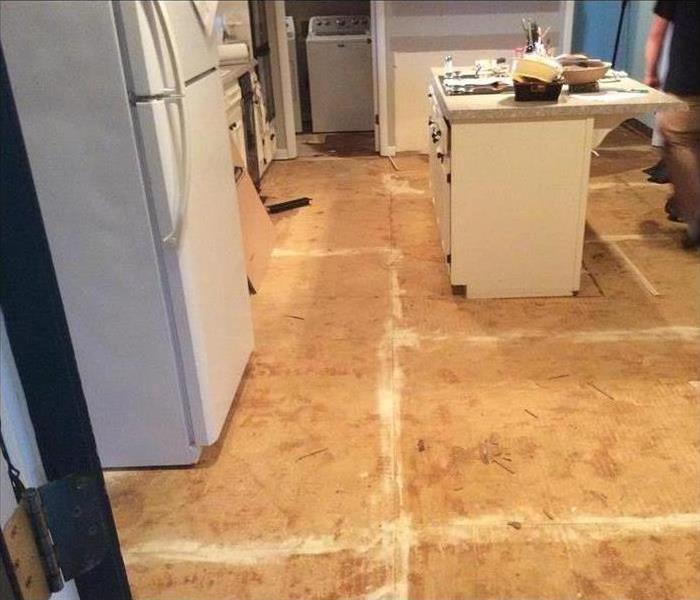 Flooring damaged by water loss in a Cookeville,TN kitchen
Flooring damaged by water loss in a Cookeville,TN kitchen
3 Steps for Minimizing Water Damage
It doesn't take long for a kitchen leak to turn into kitchen flooding. When you have unwanted water in the home and while you're waiting for water damage restoration professionals to arrive, take the following steps to minimize or prevent damage. After addressing immediate circumstances, don't forget to contact your insurance agent.
1. Maintain Safety
Determine whether it's safe for you and your family to remain in the home. Sometimes flooding water in home settings leads to slips and falls or electrical hazards. Be careful about lifting water-logged objects. Stick to repair tasks that are you know are safe; don't mess with gas supply lines or work in areas where water and electricity are both present.
2. Shut Off the Water
Most of the water-related repairs you do in your home won't require more than shutting of the indoor supply valve. However, you should also know where your main water supply is located. There should be an indoor cutoff valve beneath the fixtures in your home. For instance, if you're completing a kitchen repair, check under the sink for a knob connected to the water pipes. The shutoff switch for many appliances, such as the dishwasher, is located on the appliance itself.
3. Remove Excess Water
Mop or vacuum water (with a wet-dry shop vac) as quickly as possible to prevent water from sitting on wood or carpeted floors. Remove wet furnishings and set up as much ventilation as possible to get the area dried out. Portable items, such as rugs, fine art, couch cushions, small tables, and appliances, should be carried into a dry area to prevent further risk of damage.
Water damage restoration professionals can do a lot toward getting your home back into good condition. When you take quick action to turn off the water and clean up as much of the flooding as possible before the Cookeville, TN, professionals arrive, your home will be in even better shape.
What to Do About Crawl Space Water
10/8/2018 (Permalink)
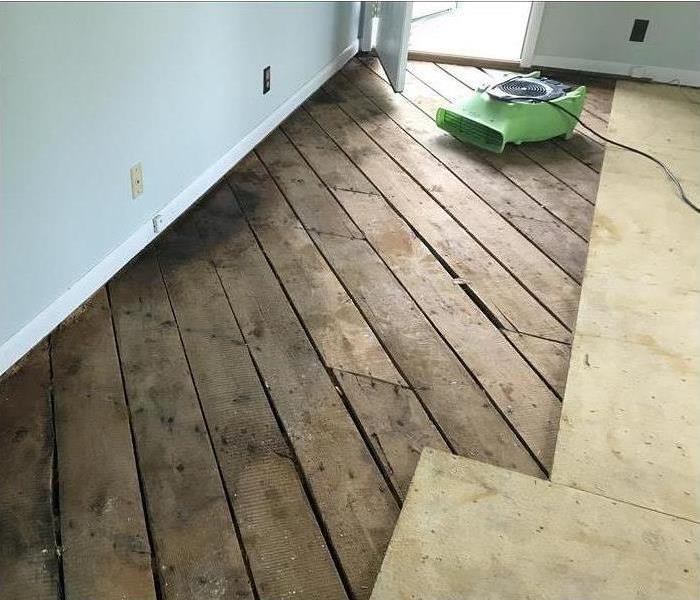 Air mover on a water damage in a Cookeville,TN home
Air mover on a water damage in a Cookeville,TN home
When you live in Cookeville, TN, finding a wet crawl space in your home may not be something you immediately think can cause problems in your home. However, if left unattended water in the crawl space can lead to foundation damage and eventual mold growth.
Reasons Crawl Spaces Get Water
While it seems like a small area to worry about, discovering water in the crawlspace is not uncommon. Finding flooding in your crawl space can happen for several reasons.
- Broken water lines
- Subterranean water
- Heavy storm rains
- Improper drainage from downspouts and gutters
- Improper sloping of landscaping
- Over watering of landscaping
The first two in this list are perhaps what most people think crawl space water is from. However improper drainage from spouts and landscaping, and over watering can be equally culpable, and more preventable.
How to Deal With Crawl Space Water
If you find you have a wet crawl space or potential flooding issue it’s best to contact a professional to deal with the problem. They can assess the area containing flood water, and do what's needed to take care of the problem, find the water’s source, repair any damages, and further protect your home.
Tips for Preventing Water in the Crawl Space
There are a few things you can do to help prevent flood damage in your crawl space on your own. You can grade your landscaping so it slopes away from your home, and include irrigation or base layers into your gardens or flower beds to help direct water away as well. Also ensure all hoses have been turned off after the watering is completed. Downspouts should include a back-splash and be angled away from the building, while regularly cleaning and maintaining gutters can help prevent water overflow that pools around the home’s foundation.
If you find you have a wet crawl space it’s best to quickly contact a professional to discover the root of the problem. Remember, there are thing you can do to protect your home as well.
Ways To Keep Water out of Your Crawl Space
8/14/2018 (Permalink)
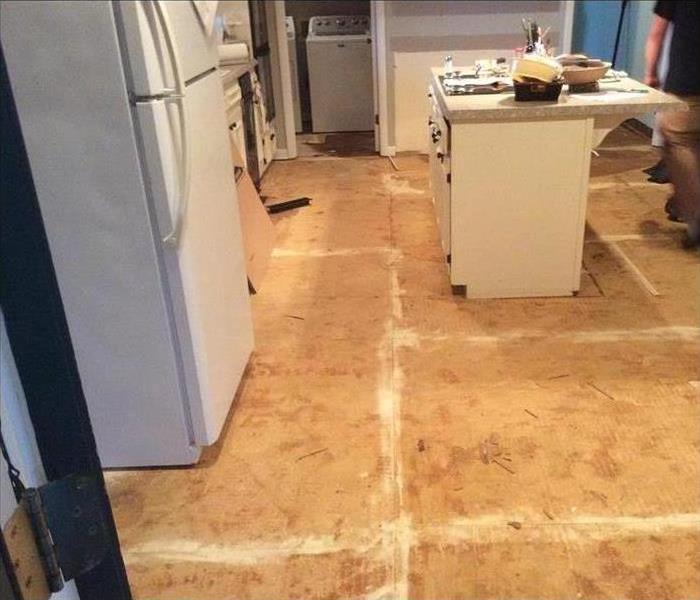 Floor damaged caused by water loss in a Cookeville, TN home
Floor damaged caused by water loss in a Cookeville, TN home
When it comes to flooding at home, basements, cellars and crawl spaces are among the most common places to find water. While you may not worry too much about a little water in this tiny part of your home, if you neglect the problem, it could lead to more serious issues in your Cookeville, TN, home. Make sure you take the proper action to help ensure you don’t end up with a wet crawl space.
How it Happens
As a homeowner, you have a host of matters you must deal with to keep your home safe. A flood can frustrate you because of the cleanup and repair costs, not to mention to potential health and safety hazards. Here are some signs your crawl space may be at risk for water buildup:
- Broken underground lines
- Poorly graded property
- Broken or incorrectly installed downspouts and rain gutters
Pay Attention to Landscaping
One of the biggest culprits for a wet crawl space is when your property doesn’t have the right slope. Your lawn and other landscaping should slope away from your home so when heavy rain comes, it won’t build up on your property and find its way into your basement. Make sure water is draining away from your house.
Don’t Water too Much
If you’ve got a garden or flower bed close to your home, be careful about how much you water it. Overwatering can easily cause water to leak into your crawl space and cause flooding.
Check Your Rain Gutters
If a storm hits, you count on rain gutters and downspouts to guide water away from your home toward the street. Check these on your house to ensure they are collecting water near your foundation or window wells.
If you’re worried about a wet crawl space, get in touch with a professional to inspect your property. These technicians can also help you clean up after a flood.
Why Do I Have a Wet Crawl Space?
6/22/2018 (Permalink)
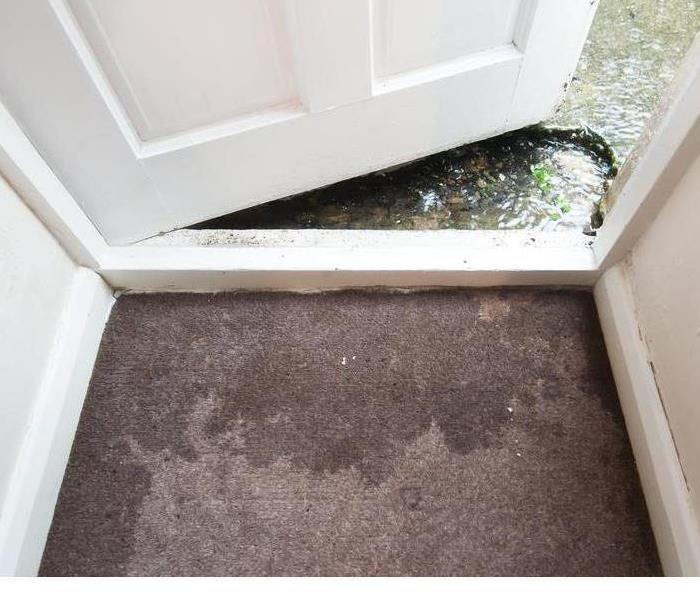 Unfortunately, you may encounter a wet crawl space at your home in Cookeville, TN.
Unfortunately, you may encounter a wet crawl space at your home in Cookeville, TN.
April showers bring May flowers. As a homeowner in Cookeville, TN, you know that April showers can also bring flooding, and sometimes a wet crawl space. Moisture under your house can wreak havoc above as well. Protect your home by understanding the following 4 causes and preventative measures:
1. Gutters
You may not realize that improperly placed gutters and downspouts invite flood water into your home. Check your gutters often for debris and clean them out when necessary. Aim downspouts away from your house and attach a 2-foot block at the end to direct rainwater further away.
2. Landscape Gradient
Rainwater follows the laws of gravity, so pay close attention to which way your yard slopes. Does your landscaping incline as it moves away from the house? If so, water is invading the foundation and draining into the areas around the crawl space. Next time it rains inspect your yard and pay specific attention to where the water pools. If there is standing water next to your home, look into readjusting the slope of your yard.
3. Outdoor Watering
Even on a beautiful, dry spring day, there is the possibility of a wet crawl space. The danger is something you least expect: yourself. Those breathtaking flowerbeds you plant against your house may be draining into your home. Overwatering foliage and accidentally leaving a hose running create the possibility of a man-made flood.
4. Broken Pipe
Whether a pipe breaks inside or outside of your home, the water can travel downwards and find its way into your crawl space. Be aware of any suspicious wet spots in your carpet or walls that may hint at a leaky pipe so you can quickly take action to avoid further damage.
Unfortunately, you may encounter a wet crawl space at your home in Cookeville, TN. Regardless of whether a torrential downpour proves too much for your landscaping, or you leave the hose on overnight, a water restoration specialist is there to help. Acting quickly to reduce loss, the experts efficiently dry, disinfect and restore your space and belongings. Talk to your insurance agent to check if water damage is covered under your policy. For more information, visit http://www.SERVPROcookevillecarthagesmithvillewoodbury.com/.
Cookeville 24 Hour Emergency Water Damage Service
3/9/2018 (Permalink)
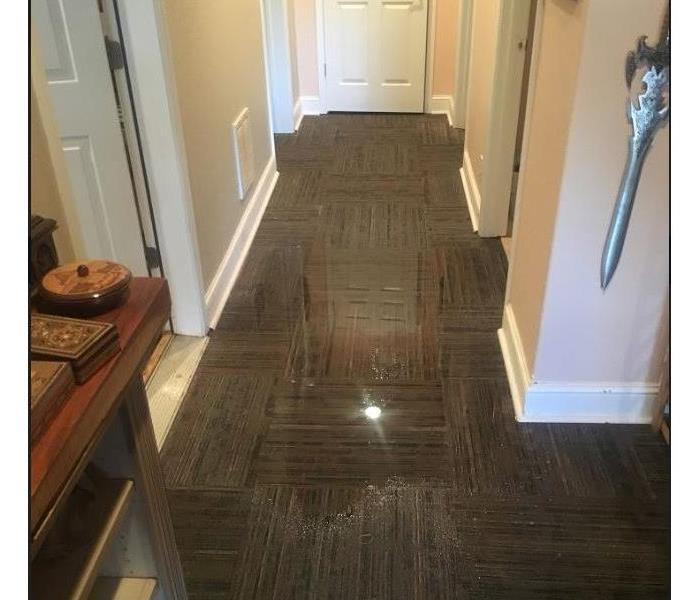 SERVPRO of Cookeville/Carthage/Smithville/Woodbury provides 24 hour fire and water damage restoration service to the Upper Cumberland.
SERVPRO of Cookeville/Carthage/Smithville/Woodbury provides 24 hour fire and water damage restoration service to the Upper Cumberland.
SERVPRO of Cookeville/Carthage/Smithville/Woodbury is available 24 hours a day for water emergencies, large or small. When you are dealing with water damage, immediate action is crucial. A delay of just a few hours can greatly increase the severity of the water damage.
We Answer the Phone Ready to Help
Call Today - (931)528-9292
We understand that when you call us, you may be feeling confused, stressed, and vulnerable. You need an expert to guide you through this crisis. SERVPRO of Cookeville/Carthage/Smithville/Woodbury has the specific water damage training and experience to help you through this tough time. We specialize in water damage restoration—in fact, it's the cornerstone of our business.
What to Expect
When you call, we will ask several questions regarding your water damage emergency. These questions will help us determine what equipment and resources to bring, including how many trained SERVPRO Professionals may be needed.
Our SERVPRO Representative will ask several questions:
- Your name and contact information
- Your insurance information (if applicable)
- The street address of the water-damaged home or business
- When did the flooding or water damage occur?
- What caused the water damage (if known)?
- Is there electricity available (on-site)?
About SERVPRO of Cookeville/Carthage/Smithville/Woodbury
SERVPRO of Cookeville/Carthage/Smithville/Woodbury specializes in the cleanup and restoration of residential and commercial property after a fire, smoke or water damage event. Our staff is highly trained in property damage restoration. From initial and ongoing training at SERVPRO’s corporate training facility to regular IICRC-industry certification, rest assured our staff is equipped with the knowledge to restore your property.
Meet our crew!
Spock's Guide to Drying Water Damage
3/8/2018 (Permalink)
"Fascinating is a word I use for the unexpected; in this case, I would think interesting would suffice."
Water damage is something we come into contact with on a daily basis. Some days it could be a small water leak from a loose plumbing fixture. Other days it could be a three story loss from a sprinkler head bursting.
No matter the size, the same principals apply to drying a structure. There's a scientific technique behind the process, and here it is, explained by Spock:
"Once you have eliminated the impossible, whatever remains, however improbable, must be the truth."
The first step in the drying process is an inspection, also known as a Loss Assessment Report. Upon arrival, the water technician must first assess any health concerns and safety hazards. Depending on where the water came from (sewage compared to a washing machine overflow) there could be pathogens that have the potential for serious adverse health effects. Structural damage or exposed wires would be a safety concern.
Determining the source of the water intrusion is also important in the drying process. Before the drying can begin, the water source must be stopped and the extent of intrusion evaluated.
Once the water source has been stopped, the technician can begin scoping the damage. Moisture meters are used to determine the saturation of materials and boroscopes can be used to view inside cavities for a better understanding of the structure's condition.
"A dazzling display of logic."
Logically, the next step in the drying process is to remove any standing water. The primary purpose of water extraction is to stop any further water migration. This prevents other surfaces and rooms from being affected, so it should be done as quickly as possible.
The other reason for water extraction is to speed up the drying time. The only ways for water to be removed from a home or business is evaporation or extraction. The more water that is extracted, the less that will need to be evaporated.
"Change is the essential process of all existence."
To completely dry a structure, a technician must increase the rate of evaporation from the wet materials. Evaporation will increase when the temperature is raised, when drier air is used, and when air is moved across the wet surface.
In order to achieve this, a number of different types of equipment is used. Air movers are essentially compact, high velocity fans. By strategically placing them in an affected area, the air movers help accelerate the rate warm air heats the surfaces. Industrial dehumidifiers balance the drying system by removing the moisture that air movers sweep away from wet materials.
"Insufficient facts always invite danger."
A lawyer will tell you if it's not documented, it didn't happen. In the restoration industry all activities that relate to a job should be documented by the water technician. After the first 24 hours of drying, materials should be monitored to determine if progress has been made. The materials should be monitored every 24 hours after, until the drying has been completed.
If you've had water damage in your home, call SERVPRO of Cookeville/Carthage/Smithville/Woodbury for 24/7 emergency services.
Understanding and Preventing Ice Dams
1/13/2016 (Permalink)
Understanding and Preventing Ice Dams
Ice dams can be incredibly destructive in the winter. They can cause leaks that rot away the structure of the house. Fortunately, they can be prevented with a little maintenance and care. You should understand what ice dams are and how to prevent them from forming.
Understanding What an Ice Dam Is
An ice dam is something that forms on the edge or lower portion of your roof. The dam is an area of ice that acts like a wall. Ice dams stop snow and water from moving naturally off your roof. The water will begin to accumulate on your roof behind the dam. Ice dams are dangerous because the water on your roof will usually flow under the shingles and into your home. This can cause a massive amount of water damage to the structure of your house. Additionally, the ice itself could punch a hole in the roof that allows water to enter. The dam could tear the gutters out opening a new path where water can enter the house.
Why Ice Dams Form
An ice dam can form on any home when the temperatures are right and there is snow on the roof. The main cause of ice dams is the constant melting and then refreezing of water and snow. The melting snow rolls down the side of the roof. The cold air then causes it to freeze. If this process is allowed to go one for some time, then the frozen patches of water will start to grow. This occurs until a tall dam has formed. Homes that are emitting a large amount of heat through the roof are more vulnerable to ice dams.
Attic Ventilation
One of the main ways to prevent ice dams is to make certain the attic has good ventilation. A warm attic will cause the snow on the roof to continually melt. The cold weather will cause it to refreeze until an ice dam appears. You should install a fan or other ventilation system so that your attic stays cool in the winter. It will also help to repair any holes or gaps in the roof where water could find a way into your house.
Upgrading the Gutters
Another option to prevent ice dams is to upgrade the gutters along the edge of your roof. There are now gutter heating systems available. A series of cables are installed down the length of your gutters. A shield is placed on top of the gutters. The cables are actually heating elements. Any snow or ice that gathers on the edge of your roof is melted with this gentle heat. This reduces the chance that any amount of ice will accumulate and create a dam causing water damage.
Keeping the Roof Clean
If your home is prone to ice dams, then you need to keep the roof clean. This means removing as much snow from the roof as possible. Many tools and devices are available that can be used to safely remove snow from a roof without requiring you to climb a dangerous ladder in the winter. Removing the snow prevents it from melting and refreezing into an ice dam.
Breaking Up an Ice Dam
If there is an ice dam already on your roof, then it is possible to break it up manually to minimize damage. You will need to use a tool to slowly chip off pieces of the dam. The goal is to create a channel through the dam so that the water trapped behind can escape and flow off the roof. This can temporarily solve the problem although the channel will likely fill in with more ice over time.
Our technicians are highly trained and experienced with every water damage situation from sewage damage clean up, mold removal, smoke damage repair, fire damage repair, flooded basement, wet carpet, wet walls, carpet water damage, basement water damage, flooded crawl space, sewer backup, sewage removal, mud removal, commercial water damage, restoration, house water damage, building water damage, hotel water damage, flooded building, crawl space water damage, crawl space sewage damage, pump out and dry out.
When your home is being threatened by water damage from flooding or leaks, SERVPRO of Cookeville/Carthage/Smithville/Woodbury's staff have the expertise to prevent or mitigate the devastating effects water damage can have in order to help preserve and restore your property. Our Professionals have the equipment and experience necessary to handle the most challenging water damage and removal situations and are available around-the-clock. SERVPRO of Cookeville/Carthage/Smithville/Woodbury professionals concentrate on safely drying, deodorizing and disinfecting the areas flooded or damaged by water.
SERVPRO of Cookeville/Carthge/SmithvilleWoodbury proudly serves Putnam, Smith, DeKalb, Cannon, Cumberland, Jackson, Overton and surrounding counties.
Contact SERVPRO of Cookeville/Carthage/Smithville/Woodbury Regarding Your Water Damage Emergency - (931)528-9292
Four Ways to Lessen Winter Insurance Woes
12/4/2015 (Permalink)
For residents of the East Coast, the winter of 2014–15 served up some of the snowiest and coldest conditions on record.
For insurance companies, this was also one of the costliest seasons on record — more costly in fact than Superstorm Sandy.
The majority of homeowners’ losses were the result of ice dams and frozen pipes, many of which could have been prevented.
Claims and risk management teams studied losses to understand how they could have been prevented. Based on these insights, we have compiled advice that you can use to help them mitigate winter weather-related risks, this year and beyond:
1. Fortify an unoccupied home
Risk: Homeowners who are away from home at the time of a loss are at greater risk of devastating damage due to a delayed response. In fact, homeowners who were away from home when a loss occurred experienced more than four times the amount of damage from burst pipes.
Recommendations: Install a whole-house leak detection system that includes an automatic water shut-off option. These devices, such as Leak Defense System, can detect abnormalities in a pipe's water flow and automatically shut off the water supply—preventing a major loss from occurring. Smart thermostats, like Nest, can remotely alert homeowners of any temperature changes that could lead to a frozen or burst pipe.
Actual loss story: While away on vacation, a family's burglar alarm system alerted them to movement within the home. The police department saw no signs of a break-in, but when nearby family members inspected the home they discovered not one but four burst pipes. The burst pipes allowed for water, which had been running for more than 24 hours, to leak onto each level of the home, causing a $1 million loss.
2. Address uninsulated pipes
Risk: During periods of extreme temperatures, uninsulated pipes are at high risk for freezing and bursting. The risk is increased because these pipes are often located in unheated spaces, like the attic.
Recommendations: Pipes in unheated areas, along with all exposed surfaces (like tees and valves) should be properly insulated with flexible closed cell polyethylene or elastomeric insulation or wrapped in self-regulating heat cable. Both can be found at most home improvements stores for around $5 each. Attics should also be adequately insulated and ventilated.
Actual loss story: When a pipe burst in the attic of a homeowner's secondary home, water flowed unnoticed for weeks until a neighbor spotted the issue. By that time, the water had caused extensive damage throughout the home. The result was a loss of more than $2 million.
3. Protect the roof against ice dams
Risk: Ice dams form after heavy snowfall, when heat radiating from a home causes the underside of a snow layer to melt. The melted snow drains along the roof until it cools and freezes into an ice dam, trapping future runoff from draining. This water can then leak into a home through the roof.
Recommendations: A properly insulated and adequately ventilated attic is critical in maintaining proper temperature and airflow. A roofing underlayment can help prevent water from leaking through the roof. Schedule a roof inspection before the start of winter to identify any weak spots and to replace damaged shingles or tiles, and arrange for gutters to be cleaned prior to the winter season. Regularly remove snow from the roof, especially following large storms. Clients with aluminum or copper gutters should install heated cables to gutters and downspouts to prevent melted snow from freezing.
Actual loss story: After several large snowstorms in a hard-hit area of the Northeast, a MA resident noticed water seeping through the ceilings and walls within an area of their home. Upon inspection it was found that the water was in fact melted snow seeping in through the roof. The resulting damage was severe and would require structural repairs. The claim totaled $200,000.
4. Assess risk outside the home
Risk: Damage from burst pipes does not exclusively originate from pipes inside the home. If property includes an outdoor system such as a swimming pool, it can cause pressure to connected indoor piping, which can burst.
Recommendations: Advise your clients to properly winterize all outdoor systems: Close any inside valves that supply outdoor hoses and open outside valves to allow the remaining water to drain, swimming pools and irrigation systems should be properly winterized, and consider replacing your garden hose faucet with a “frost proof” version, which costs about $30.
Source: http://www.propertycasualty360.com/2015/11/18/4-ways-to-lessen-winter-insurance-woes?page=5
Prevent Frozen Pipes
11/3/2015 (Permalink)
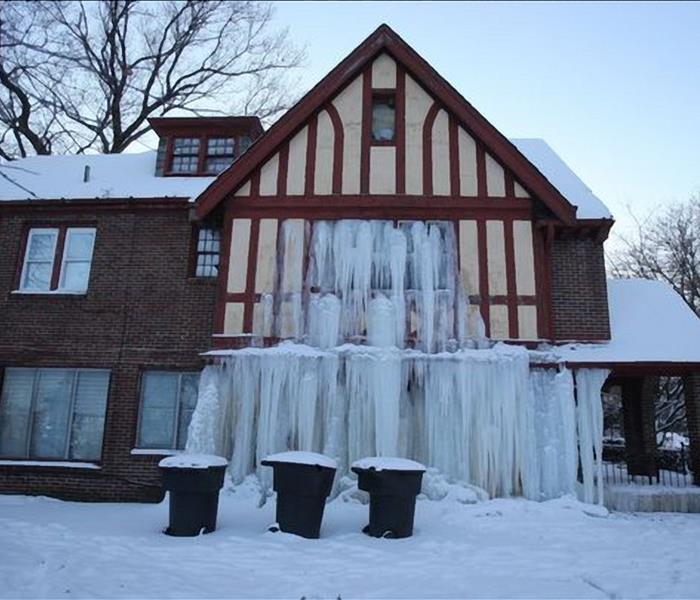 Home is frozen after pipes burst.
Home is frozen after pipes burst.
According to the Insurance Information Institute, winter storms are the third largest cause of catastrophic claims behind hurricanes and tornados. Winter damage and freezing account for almost 22% of homeowner’s claims, averaging $4,024 a claim. A crack as small as one-eighth inch in a pipe can spew as much as 250 gallons of water a day.
The science behind it is simple. We've seen it when we leave a coke can in the freezer too long and it bursts. Ice takes up about 10% more space that liquid does. But surprisingly, it isn't the expansion of ice that causes the pipes to burst. When there is an ice blockage in your pipes, the water between the blockage and the water main can recede back to the main. It has somewhere to travel. But the water between the blockage and the faucet builds pressure. If you leave a trickle in the faucet when temperatures drop below 20 degrees, it alleviates the pressure.
It's very important if you are traveling for the weekend or the holidays that you turn off the main water valve. However, if you don't empty the pipes after, you can still come home to a mess. Remember, the water that is still in the pipes can freeze and cause the pressure needed to burst.
You should also leave the cabinet doors under the sink open, especially if your sink is on an exterior wall. This allows warm air to circulate in the cabinet. The same is true of your laundry room.
When your home is being threatened by water damage from a burst pipe or any type of water damage from flooding or leaks, SERVPRO of Cookeville has the expertise to prevent or mitigate the devastating effects water damage can have in order to help preserve and restore your property. We have the equipment and experience necessary to handle the most challenging water damage and removal situations and are available around-the-clock. We concentrate on safely drying, deodorizing and disinfecting the areas flooded or damaged by water. When fire and water take control of your life, we help you take it back.
Contact SERVPRO of Cookeville/Carthage/Smithville/Woodbury Regarding Your Water Damage Emergency (931) 528-9292
Flood Water
9/3/2015 (Permalink)
Flooded areas are not only a hassle to clean, but can also threaten your health. Water that flows in from outside of your house can pick up a lot of bacteria on the way before it even enters the house. Having the water sit, especially on a humid day, can cause more bacteria and mold growth. Getting the area cleared out and cleaned up as fast as possible will prevent the situation from getting worse and causing more water and mold damage.
According to the IICRC, these are valuable tips for cleaning up after a flood has left water damage in your home.
- Safety is first and foremost. Be cautious when enterin buildings that have been flooded. Ensure that the electric is turned off and the structure of the building is safe to walk into.
- Keep the area ventilated. Flooded waters can bring in all different types of bacteria that can become airborne and cause illness. Make sure to open windows and place a fan in the window to ventilate the area.
- Know what to throw away and what to salvage. Any type of porous item the absorbs the contaminated flood water should not be salvaged. Examples-drywall, carpet, mattresses, pillows, box springs, and particle board. Clothing and some other household fabrics may be salvageable by sosaking in warm water and washing multiple times.
- Prevent mold growth. With the moist environment that is created by a flood, there is lots of room for mold to grow. Try to keep the air circulating and maintain moderate temperatur to prevent mold growth.
As leaders in the water damage industry, SERVPRO of Cookeville/Carthage/SmithvilleWoodbury has advanced training and expertise, not to mention a tremendous amount of hands-on experience. We use this training and experience to quickly dry your home and restore it back to pre-water-damage condition. Our process includes documentation of the drying process to validate your property is dry.
Source-http://www.iicrc.org/consumers/care/water-damage/
Injectidry Hardwood Floor Drying System
5/14/2015 (Permalink)
We've updated our inventory! The Inject dry Hardwood Floor Drying System is the latest and greatest hardwood dryer in the industry. It's used to dry high-risk areas of moisture under hardwood, marble, and tile that regular dehumidifiers just can't quite reach. By exchanging the air in a targeted area with negative pressure, the air movement becomes a vehicle for moisture. When caught in time, this can keep your expensive hardwood and engineered hardwood from warping.
SERVPRO of Cookeville/Carthage/Smithville/Woodbury specializes in: water remediation, flood mitigation, carpet cleaning, tile and grout cleaning, mold removal, fire damage, and smoke clean up, disaster restoration, storm response, and air duct cleaning. SERVPRO of Cookeville/Carthage/Smithville/Woodbury serves the Upper Cumberland area. We are licensed and insured and have an A+ rating with the better business bureau in restoration and cleaning. Call us for any of your cleaning or restoration needs at (931) 996-9113
 When flooding strikes, call SERVPRO of Cookeville/Carthage/Smithville/Woodbury for a faster response to recovery!
When flooding strikes, call SERVPRO of Cookeville/Carthage/Smithville/Woodbury for a faster response to recovery!





 24/7 Emergency Service
24/7 Emergency Service











